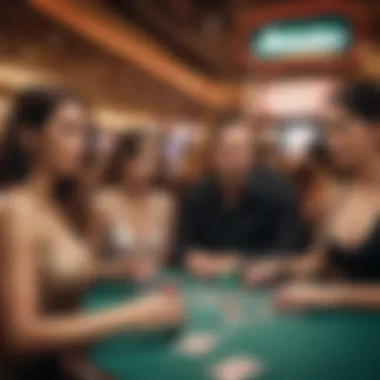Exploring Body Experience in Las Vegas Culture


Intro
Las Vegas is a city that buzzes with life, painting a vivid tapestry of sound, color, and movement. The physical and cultural landscape here creates a distinct body experience, one that pulls in locals and tourists alike into a whirlwind of sensations. From the moment you step onto the Strip, the wafting scent of diverse cuisines and the pinging sound of slot machines tease your senses, beckoning you to dive into this sensory playground. But what exactly does it mean to engage physically and culturally in a space as electrifying as Las Vegas?
This exploration takes a closer look at how your body interacts with this vibrant city, emphasizing why understanding your bodily experiences is crucial for fully embracing the Las Vegas phenomenon. Whether you’re an avid gambler strategizing your next move, a casino player relishing the thrill of the game, or a cultural enthusiast soaking up the local vibe, this article unfolds the intricacies of bodily experiences shaped by the city’s dynamic features.
Prelude to Body Experience
Understanding how bodies engage within a specific environment sheds light on individual and collective experiences in that space. This is especially true in a place like Las Vegas, where physical presence often intertwines with cultural nuances. Bodies don’t simply occupy space; they interact, perform, and express identity in ways that can impact social dynamics.
As we embark on this exploration, we’ll unpack how the Las Vegas atmosphere adds unique layers to body experience. It’s about not just the thrill of chance or a strategic poker face, but how individuals navigate movement, sensation, and the social fabric of the city.
Defining Body Experience
At its core, body experience refers to the multifaceted ways in which individuals perceive and act with their physical forms in relation to the world around them. This includes everything from the posture we adopt while seated at a gaming table, to the energetic flow of bodies moving through crowded streets. In Las Vegas, the interactions are magnified – a deliberate choice of attire for a night out might speak to a visitor's desire to impress, while the way one lounges at a blackjack table might hint at confidence or strategy.
The nuances of body experience can be boiled down to three primary elements: physicality, sensation, and movement. These elements serve as the backbone of our exploration, diving deeper into how Las Vegas’s unique charm influences behavior. Whether it's the electrifying lights or the sounds echoing from slot machines, each facet shapes how bodies both feel and act.
Relevance in Urban Settings
Urban environments, like Las Vegas, offer a rich context for studying body experience. The concept extends beyond the individual; it captures the essence of cultural identity, social interaction, and the dynamics of community.
In Las Vegas, the identity is porous; people come together from different walks of life, forming a mixed tapestry of experiences. In this bustling melting pot, the body is a tool for making connections. For instance, consider the traditional act of sharing a laugh or exchanging greetings; these interactions often involve significant non-verbal cues—smiles, hand movements, or even a raised eyebrow. Such gestures can forge unspoken bonds among strangers in vibrant settings.
Moreover, urban life comes with its challenges and benefits—navigating a crowded Strip can be chaotic, but it’s also exhilarating. The body becomes an instrument of adaptability, responding to both the rhythms of the city and the social cues presented by others.
"The body does not simply move; it engages, interacts, and transforms within each unique urban landscape, shaping experiences that resonate far beyond physical limitations."
Las Vegas: A Unique Context
Las Vegas stands as a remarkable example of a city that is not just a backdrop for life but an active participant in shaping the bodily experiences of its inhabitants and visitors. The urban setting, filled with a unique blend of entertainment, cultural influences, and a vibrant social atmosphere, fosters a distinctive environment where physical presence holds significant meaning. From the bustling Strip, lined with extravagant resorts and neon lights, to the more intimate local spots, the context in which individuals navigate that city provides insight into their physical and cultural engagement.
The importance of exploring Las Vegas arises from its status as a hub of entertainment and a global symbol of gambling. Individuals from varied backgrounds come to the city, each carrying their narratives and expectations that mold their interactions with the space. This synergy between people and place invites a closer look at how one’s body and senses interact within this tantalizing urban tapestry.
City Overview and Cultural Landscape
To grasp the body experience in Las Vegas, it’s crucial to first understand its cultural landscape. Las Vegas is a city that thrives on spectacle. The skyline showcases architectural marvels and grandiose casinos, which create a sense of awe and anticipation. The city pulses with life, thanks to its year-round events, festivals, and showcases that celebrate different cultures.
- Eclectic Mix of Influences: Las Vegas is a melting pot, blending various cultural elements, including art, music, and cuisine. This mixture influences how people move and engage.
- The Place for Performers: From the Strip’s showgirls to street performers, physical expressiveness is not just celebrated, it’s the lifeblood of the city.
- Tourists and Locals: The dynamic between residents and tourists greatly informs social interactions. Locals know the ins and outs, while tourists often react in excitement, revealing a diverse rhythm to social engagement.
The cultural landscape of Las Vegas provides a rich backdrop, allowing individuals to express themselves not merely through verbal communication but by how they inhabit spaces. The way people dress, the gestures they use, and how they position themselves in relation to others all contribute to a shared understanding and experience that goes beyond spoken language.
Gambling as a Social Activity
Gambling in Las Vegas is often viewed through the lens of chance, but it envelops a far broader social dynamic. Within casinos, the act of playing games such as poker and blackjack serves as more than a pursuit of monetary gain; it becomes a communal experience.
- Shared Spaces: Casinos are designed to invite players to interact. Whether it’s the communal feeling of gathering around a poker table or the competitiveness of a slot machine area, the physical environment encourages body language.
- Social Signals: Players read each other’s body language, engaging in nonverbal communication that can shift the atmosphere of a game. A confident stance or a nervous twitch can betray a player’s state of mind, changing the stakes in both a literal and social sense.
- Building Community: Regular gamblers often develop relationships with each other and staff, forging a sense of community within the chaos. The shared experience of risk and reward creates bonds that can lead to lasting friendships.
- Cultural Events: Tournaments and themed gambling nights serve as social occasions, drawing in crowds that bring vibrancy to the activity.
"In Las Vegas, gambling transcends mere money; it's about the thrill of the chase and the connections formed in the process."
In encapsulating these perspectives, we begin to see how gambling effectively embodies the essence of body experience, highlighting the physical engagements that occur within these shared social arenas. Overall, the uniqueness of Las Vegas as a context enriches the understanding of how the body interacts with culture, movement, and space in a manner unlike any other city.
Physical Movement in Las Vegas


In the vibrant cityscape of Las Vegas, physical movement plays a critical role in shaping how individuals interact with their surroundings and fellow adventurers. The very essence of this bustling environment speaks to the energy exuded in the rhythm of footsteps, the sway of bodies around slot machines, and the collective pulse of crowds streaming to and from world-class entertainment venues. Understanding physical movement in this context isn't just about mobility; it’s about engagement and being immersed in a unique cultural tapestry woven with diverse experiences.
Navigating the Urban Terrain
Navigating the streets of Las Vegas offers an experience distinct from that of a typical city. Each step resonates differently on the Strip, where occasionally, flashing billboards and neon signs catch the eye, pulling attention in myriad directions. The concept of wayfinding becomes vital here. Unlike many urban environments where a mere glance at a map suffices, Vegas requires one to navigate not just physically but also mentally through stimulation overload.
- Landmarks as Guides: Familiarize oneself with notable buildings like the Bellagio and its famous fountain or the Eiffel Tower replica. These iconic structures help orient not just tourists but locals too. Navigating towards these landmarks gives a sense of destination, even in a maze-like casino.
- Flow of Movement: It's a dance of sorts, the ebb and flow of casino-goers weaving through tightly packed spaces. Observing how people move can unveil much about social dynamics; some walk rapidly, eyes glued to smartphones, while others stroll leisurely, soaking in the sights.
Striding forward, one becomes acutely aware of the diversity of bodies in motion: from families with strollers to groups of friends celebrating a night out. This diversity highlights how movement reflects broader cultural identities.
Spatial Awareness in Casinos
Once within the casino, the spatial awareness shifts entirely. The layout is meticulously designed to both attract and retain visitors' attention. Each inch is crafted to create a sensory overload that makes you feel alive yet slightly disoriented.
- Design Elements: The absence of clocks and windows distorts time perception, while the arrangement of tables, machines, and lounges invites us to explore further. It's as if the casino is a labyrinth, and for many, the goal is to discover pathways to luck or success.
- Interpersonal Dynamics: As individuals engage with various games, interactions become telling. Body language paints a story of anticipation, frustration, joy, or disappointment. Players often share glances and subtle nods or even celebrate small wins together, solidifying a collective experience in that moment. The effect of a shared space amplifies these interactions.
Comfort and discomfort coexist in these busy spaces, blending entertainment and the thrill of chance. As one moves through this environment, they are not just participating in games but also engaging in a rich cultural dialogue—a dance of bodies in a city that thrives on both physical and cultural identities.
"In Las Vegas, every stride and shuffle is more than mere movement; it's an expression, an interaction, a little part of the broader tapestry of experience."
In essence, physical movement in Las Vegas is a tapestry of interactions shaped by the built environment. It brings life to the experience of being in a place where every step could lead to unexpected joy or discovery.
Sensory Engagement: A Multi-Layered Experience
Sensory engagement plays a pivotal role in shaping the body experience in Las Vegas. The city is a whirlwind of sights, sounds, and tactile sensations that create a comprehensive atmosphere, designed to captivate visitors and encourage them to fully immerse themselves in the urban landscape. This multi-layered sensory experience not only enhances enjoyment but also influences behavior, social interactions, and overall engagement with the environment.
The importance of sensory engagement lies in its ability to evoke emotions and memories, making every moment spent in Las Vegas unique. A combination of various sensory stimuli acts as a conduit for cultural expression, transforming a mere visit into an unforgettable adventure. Recognizing this, businesses and venues in Las Vegas meticulously curate their sensory experiences to align with the desires and expectations of their guests, particularly targeting gamblers, casino players, poker enthusiasts, gaming strategists, and hobbyists.
Visual Stimuli: Lights and Colors
Upon entering Las Vegas, the first sensation that grips visitors is often visual. Neon lights and vibrant colors dazzle the eyes, creating an almost hypnotic effect. The Strip is notorious for its extravagant displays that promote not just a sense of excitement, but also a deeper connection to the locale. Restaurants, casinos, and hotels utilize lighting in a way that enhances the experience, enticing individuals to remain engaged longer.
- Psychological Impact: Bright lights can boost mood and create a sense of euphoria, which may inadvertently encourage people to spend more time – and money – in these locations.
- Cultural Representation: The colors and designs reflect a blend of cultural influences that shape the identity of Las Vegas, offering an insight into the city’s diverse background.
Utilizing concepts like color psychology, establishments carefully select hues that evoke specific feelings or actions. For instance, red might incite passion and energy, drawing gamblers to slot machines, while calming blue tones could offer an oasis of relaxation after an intense gaming session.
Soundscapes of the Strip
As visitors traverse the Strip, they are enveloped in a symphony of sounds that contribute to the overall body experience. From the cheerful chiming of slot machines to the epic music blasting from various venues, soundscapes are instrumental in crafting the Las Vegas atmosphere.
- Engagement through Sound: The captivating sounds create a unique auditory branding for each casino and entertainment venue. Familiar jingles can create nostalgia and seamlessly draw individuals into the gaming sphere.
- Social Interactions: Background music influences how people interact with one another. Higher tempo beats can encourage movement, promoting a social atmosphere, while mellow sounds may foster intimate interactions.
"Sounds can transport individuals through time or even place them in a particular mindset that enhances their experience."
Tactile Interactions with Gaming Equipment
The tactile experience in Las Vegas cannot be overlooked. The feeling of rolling dice, pressing buttons on a slot machine, or even the coolness of poker chips between fingers engages the body in a way that is both stimulating and satisfying.
- Physical Engagement: Handling gaming equipment establishes a physical bond with the activity at hand. This sensory involvement is crucial for gamblers, as it adds an extra layer of excitement to each game.
- Sensory Satisfaction: The texture of chips, the vibration of machines, and the smoothness of cards emphasize the multisensory engagement that is invaluable in shaping positive experiences.
This tactile relationship also seeds patterns of behavior; for instance, gamblers might develop a preference for certain machines or card games solely based on the physical sensation they provide. Thus, the sensory engagement is not merely supplementary but central to the overall Las Vegas experience.
Cultural Bodies: Identity and Expression
When we discuss the body experience in Las Vegas, we can't overlook the concept of cultural bodies. It's not just about what we do with our bodies; it’s about how our identities are expressed through our physical states and movements. In a city where everything is amplified, our bodies become canvases for identity, creativity, and community.


Cultural bodies capture the essence of who we are, blending personal histories with broader social narratives. In Las Vegas, this phenomenon can be observed in various performances, particularly in shows that fuse traditional storytelling with modern expressions.
Think about the Cirque du Soleil performances or the various street acts. These artists embody their roles not merely through the scripts and music but through their physical presence, their movements, their very being. Their bodies tell stories, reflecting the diverse identities that converge in this vibrant city. With every leap, spin, and gesture, performers convey emotions and narratives that resonate with both locals and visitors.
The Role of Performance in the City
Performance is a vital element of identity in Las Vegas. It’s not confined to the grand stages of extravagant shows; it extends to the everyday interactions on the bustling Strip. Each day, musicians, dancers, and street performers lay claim to public spaces, turning Las Vegas into a vibrant showcase of artistry and culture.
Through performance, individuals express cultural backgrounds and personal experiences. Each act invites the audience into a dialogue, encouraging them to reflect on their own identities and to engage in a shared cultural experience.
Moreover, local festivals and community events—like First Friday—highlight how the performative aspect of identity and cultural expression stretches beyond traditional bounds. Here, art takes the streets, transforming the environment into an ever-changing gallery. Performers and viewers mingle, blurring the lines between audience and artist, which inspires authenticity in the way cultures interact.
Social Interactions and Body Language
The body speaks volumes, often conveying sentiments that words cannot. In Las Vegas, social interactions are layered with meaning, influenced by the vibrant atmosphere that surrounds them. Body language plays a crucial role in communication, especially in this context where individuals are often navigating a blend of excitement, tension, and anticipation.
For instance, the way players sit at a poker table can illuminate much about their strategies and emotional states. Subtle cues, like a clenched jaw or tapping fingers, can signify confidence or anxiety. Understanding these nuanced expressions enhances the social fabric of gambling, allowing players to connect on a deeper level.
Additionally, in environments that thrive on spectacle—like casinos and shows—body language serves as a universal language. A simple nod, a smile, or an expressive gesture can break barriers between strangers, fostering connections that might not occur in a different city. The body becomes a bridge, linking diverse individuals together through shared experiences.
In summary, the cultural body in Las Vegas thrives on performance, expression, and social interaction. As we observe and participate in the whirlwind of life in the city, we become part of an evolving narrative that seamlessly weaves together identity and community—a dance as unique as the city itself.
Wellness and the Body Experience
In the bustling whirlwind of Las Vegas, wellness can often take a back seat to the neon lights and high-stakes gambling. However, the significance of wellness—both physical and mental—cannot be overstated. Well-being directly influences how individuals engage with the vibrant culture and intense experiences the city has to offer. Thus, exploring wellness in the context of body experience illuminates how visitors and residents seek balance amidst the chaos. Balancing indulgences with self-care becomes paramount in a city that thrives on sensory overload and constant activity.
Physical Health and Safety Considerations
When navigating the exhilarating streets of Las Vegas, numerous physical health considerations come into play—particularly concerning the unique risks associated with prolonged indulgence. With gambling often coupled with long hours spent seated, it’s essential to recognize how these behaviors can impact physical well-being. Here are some key points to consider:
- Hydration is key: The dry desert air can leave one feeling parched. Staying hydrated counters fatigue and ensures mental clarity while engaging in the vibrant nightlife.
- Movement matters: Walking the Strip is a workout in itself, but keeping limbs active is vital. Simple stretches or short breaks can enhance circulation and prevent discomfort from extended sitting periods.
- Nutrition awareness: Buffets and late-night meals can lead to overindulgence. Being mindful of portion sizes and opting for healthier options helps maintain energy and overall wellness.
- Mental vigilance: High-stakes environments can amplify stress and anxiety. Designating time for relaxation—be it through meditation or a quiet stroll—can do wonders for mental health.
By considering these factors, individuals can better enjoy their Las Vegas experience while maintaining a focus on their physical health.
The Impact of Excess and Restraint
Las Vegas is often a landscape of extremes, offering both excess and restraint in various forms. For many, the temptation to indulge—whether through gaming, dining, or nightlife—can quickly become overwhelming. The key lies in understanding how these excesses impact the body experience.
- Developing mindfulness: Paying attention to personal limits can transform an experience from reckless excess to a balanced celebration. It's essential to recognize when a night out is becoming too much and to make conscious choices that prioritize health.
- Restraint's role: Conversely, practicing restraint allows for moments of reflection and self-awareness, enhancing not just personal health but also the overall experience. Learning to savor the small joys, like a well-crafted cocktail or a culinary delight, fosters a deeper connection to the environment.
- Social dynamics: Interactions with others often reflect societal norms around indulgence. Engaging in conversations about healthy choices or even attending wellness-focused events can shift the social dial from excessive partying to a more grounded experience.
Ultimately, navigating the scales of excess and restraint in Las Vegas requires continuous self-assessment. By honing in on personal limits and objectives, individuals can craft body experiences that are not only enjoyable but sustainable. This balance becomes crucial in a town where hedonism often reigns supreme.
"Navigating the neon jungle isn't just about what you see, but how you feel—every choice shapes your body experience."
Technological Influences on Body Experience
The rise of technology has transformed the landscape of body experiences in Las Vegas, shaping how individuals interact with their environment, engage with each other, and participate in the iconic activities synonymous with the city. Las Vegas stands at the crossroads of tradition and innovation, making it an apt place to explore how technological advancements enhance the physical engagements that constitute the body experience. With factors like convenience, immersive gameplay, and enhanced social interactions, technology has woven itself into every fabric of the city’s offerings.
Virtual Reality and Gaming Interfaces
One of the most profound technological influences is the advent of virtual reality (VR) in gaming. In the bustling casinos of Las Vegas, one can see cutting-edge VR setups designed to engage players in an entirely new way. Imagine strapping on a headset that transports them into a vibrant and interactive casino environment, where they can experience gambling in a setting that blurs the lines between reality and the virtual. This form of engagement extends beyond mere entertainment; it offers a richer, multi-sensory experience.
- Players can practice different strategies without any monetary risk.
- Social interactions become more dynamic, as avatars can represent them in the virtual realm.
In VR environments, the sensation of space and movement is redefined. By providing realistic interactions, users can physically engage using motion controls, which connects the body to the game in an unprecedented way. The visceral feedback, combined with lifelike visuals and sounds, ensures that players feel the adrenaline rush as if they were at the actual tables.


Emerging Trends in Experience Design
As the technological landscape continues to shift, Las Vegas embraces emerging trends in experience design that prioritize not just participation but also the overall emotional journey of visitors and players. Enhancements in interface design play a significant role in this. Gamblers today expect not only games that are engaging but ones that fit into their lifestyle seamlessly.
Some compelling trends growing in prominence include:
- Augmented Reality (AR) Enhancements: This technology blends the virtual and real-world elements, creating interactive experiences in physical spaces. Casino goers might find themselves surrounded by animated digital elements that heighten their sensory engagement.
- Wearable Technology: Devices that track health or provide real-time information about the gambling environment. For instance, smartwatches can alert users about high-stakes games or their health metrics as they navigate through casinos.
- Gamification Elements: Incorporating game-like features in non-game contexts, rewarding players even when they are not winning. This approach not only maintains engagement but also fosters social bonds among participants.
"Technology in Las Vegas isn’t just a tool; it’s a participant in the body experience, influencing how we gather, interact, and play."
In summary, technological influences reshape the body experience in Las Vegas by offering a suite of tools and innovations that redefine engagement. Virtual reality and emerging trends in experience design not only enhance participation in gaming but also promote a sense of community and shared experience. The city's capacity to adapt and integrate these elements will undoubtedly continue to evolve, ensuring a dynamic and immersive future for all who visit.
The Future of Body Experience in Las Vegas
The landscape of Las Vegas is in constant flux, shaped by the ever-evolving expectations of its visitors and the broader trends in society. This section delves into what the future holds for body experience in this vibrant city, emphasizing the importance of understanding these shifts. As casinos and entertainment venues seek to redefine the visitor journey, recognizing the changing demands of tourists becomes paramount.
Shifts in Tourist Expectations
The expectations of tourists are shifting like sand dunes in the desert. Modern visitors are not just looking for places to gamble or shows to watch; they desire immersive experiences that engage all their senses.
This new wave of tourists is increasingly focused on personalization and interaction. Travelers want to feel a part of the experience rather than mere spectators. For instance, hotels and casinos might use advanced technology, like augmented reality, to create interactive environments that allow guests to participate in gaming experiences in a more engaging manner.
Some key aspects driving these changes include:
- Cultural Immersion: Tourists are seeking authentic cultural experiences that reflect the local community rather than the standardized fare of previous eras. This includes engaging in local art, cuisine, and live performances familiar to the Las Vegas landscape.
- Social Connectivity: Many visitors wish to share their experiences on social media. Thus, venues are integrating Instagram-worthy installations and moments that visitors will want to capture and share, enhancing both memory and social engagement.
- Health Consciousness: As more travelers become health-conscious, there's a growing interest in wellness-focused amenities, such as spas, nutrition-focused menus, and fitness-centered activities, providing a holistic body experience in a city known for excess.
"The future of Las Vegas hinges upon its ability to harmonize traditional thrills with the evolving desires of its guests, creating a landscape where interaction and immersion reign supreme."
Sustainability and Wellness Trends
In addition to evolving expectations, sustainability and wellness are becoming more central themes in Las Vegas's body experience landscape. The city's growth has previously been linked to excess and indulgence, but there's an emerging trend where the focus is shifting towards balance and responsibility.
- Eco-Friendly Initiatives: Many establishments are adopting sustainable practices in their operations. This can be seen in the increasing use of energy-efficient technologies, sustainable materials in construction, and eco-friendly goods in dining.
- Wellness-Oriented Design: Architecture and layout of casinos and hotels are adapting to promote well-being. This can include thoughtful designs that allow natural light, greener spaces, and facilities that encourage physical activity and relaxation.
- Holistic Experiences: With a heightened emphasis on health, visitors are more invested in activities that promote mental and physical wellness. Workshops, retreats, and physical activities that leverage the beautiful nature surrounding Las Vegas are now gaining traction.
Connecting with the principles of sustainability, wellness trends set the groundwork for new offerings and experiences that cater to modern sensibilities.
As Las Vegas continues to innovate and adapt, the focus will not just be on creating the ultimate entertainment destination but also on fostering environments that enrich the body and mind, promoting a more balanced approach to leisure and fun.
Ending
Reflecting on the body experience brings us to an understanding that transcends just mere physical activity; it dives into the very heart of engagement itself. Las Vegas, as a bustling metropolis, serves not only as a playground for tourists but also as a stage for social dynamics, cultural identities, and individual narratives. The interplay of people within its vibrant setting highlights how one’s body becomes a vessel of experience, narrating stories of joy, tension, and community.
When discussing the implications of such bodily engagement in Las Vegas, we uncover a treasure trove of ideas. Firstly, it’s essential to recognize the ways bodies communicate through movement and expression. From the sway of a dancer to a player’s focus at the poker table, it’s all connected. Bodies aren’t just participating in activities; they are partaking in a wider social commentary—be it celebrating wins, grappling with losses, or simply existing in a space alive with energy.
Moreover, the sensory experiences that Las Vegas offers—be it the dazzling lights, the cacophony of sounds, or the tactile sensations associated with playing games—tie the body directly to the environment. With this in mind, we see how physical presence in a city like Las Vegas contributes significantly to one’s identity and sense of belonging.
Reflecting on the Body Experience
The body experience is, quite simply, a reflection of our interactions within an environment that is as much about spectacle as it is about reality. In Las Vegas, this is amplified. Activities such as gaming aren’t just about winning or losing; they evoke emotions, forge connections, and create shared histories among participants, whether they are seasoned poker enthusiasts or curious first-timers.
A notable aspect is how the space shapes bodily experiences. Walking along the Strip involves not only moving through a physical space but also emoting reactions to visual and auditory stimuli. As individuals navigate the casino floors, they aren't just seeking fortune; they are physically and spiritually navigating the highs and lows inherent in such environments. Each body becomes a part of the urban tapestry, carrying with it stories and experiences that resonate well beyond the time spent in a single location.
Implications for Future Research
With the wealth of insights gained from this exploration, several pathways for future research arise. One significant area could explore how varying demographics interact with the city’s offerings. For instance, understanding how the body experience differs among age groups or cultural backgrounds can provide valuable perspectives on urban engagement.
Additionally, investigating the psychological impacts of excessive stimulation in environments such as casinos can lead to a deeper comprehension of well-being and health. As urban spaces evolve and shift, clarity on how physical experiences affect our mental and emotional states can inform future city planning and public policy.
Furthermore, a critical examination of bodily interactions in virtual settings could bridge the gap between the tangible and the digital world, particularly relevant in a city that embraces both. Exploring how individuals experience gaming in online spaces might mirror or diverge from their physical experiences in a casino.
Ultimately, the body experience in Las Vegas serves not only as a microcosm of broader social trends but also as a catalyst for deeper inquiries into the human experience itself. Thus, the study of body engagement and its implications remains a fertile ground for investigation, rich with opportunities to enhance our understanding of both the individual and the collective in urban settings.















